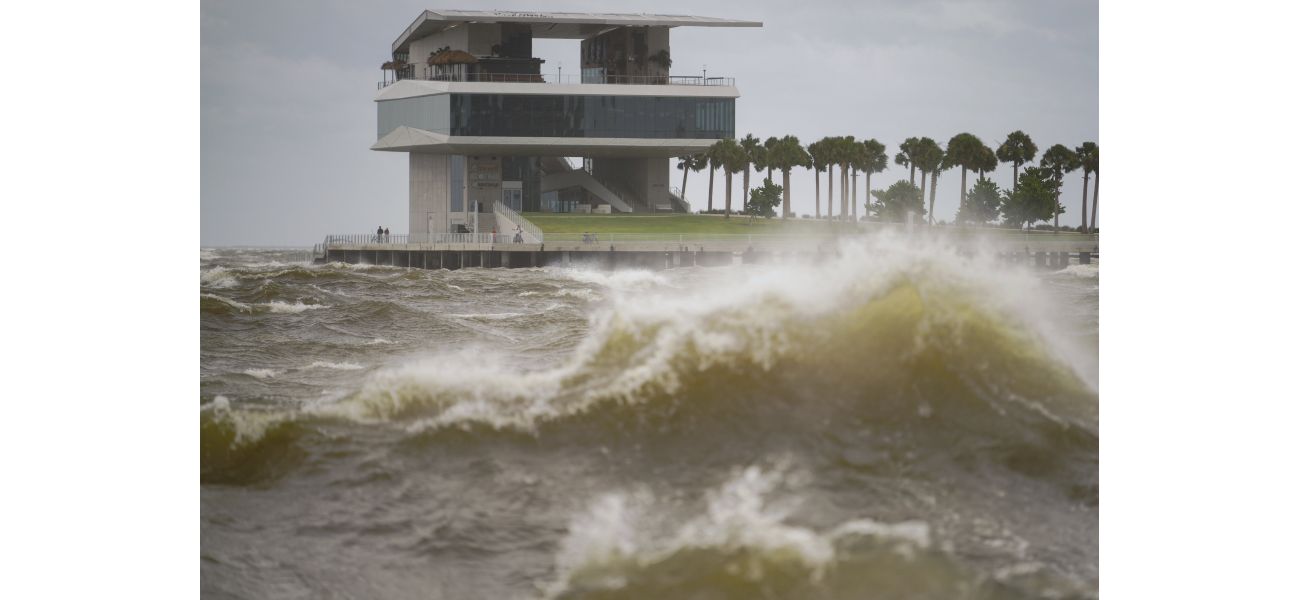Hurricane Helene reaches northwestern Florida as a strong Category 4 storm.
Several states have declared emergencies due to high winds causing power outages for over 250,000 properties.
September 27th 2024.

The state of Florida was hit hard by Hurricane Helene, a powerful Category 4 storm that made landfall in the Big Bend area of the state's northwestern coast. The storm brought with it a dangerous storm surge, damaging winds, and heavy rains that threatened to cause flash floods across the southeastern United States. As the storm approached, authorities in Georgia reported two fatalities from a possible tornado, and Florida Governor Ron DeSantis sadly announced that one person had died while driving on Interstate 4 when a sign fell onto their car.
The impact of Hurricane Helene was widespread, causing over 1 million power outages in Florida and over 50,000 in Georgia. As the storm continued to move inland, more states declared a state of emergency, including Florida, Georgia, the Carolinas, Virginia, and Alabama. Meanwhile, in the Pacific, former Hurricane John regained strength and was classified as a hurricane once again. It posed a threat to Mexico's western coast, where it could bring flash flooding and mudslides.
As the situation in Florida continued to unfold, Governor DeSantis urged residents to stay safe and be prepared for the worst. He shared the tragic news of the one reported fatality and reminded everyone to take caution in the dangerous conditions. The governor also warned that there could be more casualties and significant property damage as the storm progressed. He asked for people to keep those affected in their thoughts and prayers.
Hurricane Helene made landfall in the northwestern part of Florida on Thursday night. The National Hurricane Center in Miami reported that the storm hit around 11:10 p.m. EDT near Perry, Florida, with maximum sustained winds of 140 mph. The center warned of possible storm surges up to 20 feet, which could be catastrophic and unsurvivable in Florida's Apalachee Bay. The impact of the storm was felt beyond the coast, with hurricane warnings and flash flood warnings extending into northern Georgia and western North Carolina.
The aftermath of Hurricane Helene was devastating, with over 885,000 customers in Florida left without power by 11 p.m. EDT. The majority of these outages were in the Big Bend area, where the storm made landfall. Meanwhile, in the Pacific, former Hurricane John had been downgraded to a tropical storm as it moved slowly along the coast of Michoacan, Mexico. The storm was still a threat, with strong winds and the potential for severe flash flooding.
John's journey began when it made landfall as a Category 3 hurricane in Acapulco on Mexico's southern Pacific coast. It caused significant damage, and after weakening over land, it emerged back over the ocean. The storm then reformed as a tropical storm and regained hurricane status on Thursday. However, the National Hurricane Center predicted that it would weaken as it continued to move along the coast.
On Thursday evening, a powerful Category 4 storm named Hurricane Helene arrived at the northwestern coast of Florida's Big Bend area, bringing with it a threat of catastrophic storm surge, damaging winds, heavy rains, and flash floods. This storm was moving quickly and it was forecasted to cause devastation hundreds of miles inland throughout the southeastern United States.
As Helene approached, authorities in Georgia reported two fatalities due to a possible tornado, and Florida Governor Ron DeSantis confirmed the death of one person who was driving on Interstate 4 when a sign fell onto their car. This storm has also caused widespread power outages in both Florida and Georgia, affecting over 1 million homes and businesses.
States of emergency were declared in Florida, Georgia, the Carolinas, Virginia, and Alabama as officials braced for the impact of Hurricane Helene. Meanwhile, in the Pacific, another storm named John was gaining strength and threatening areas of Mexico's western coast with flash flooding and mudslides.
Back in Florida, Governor DeSantis urged residents to stay safe and take shelter as Helene continued to wreak havoc. He warned that there could be more fatalities and property damage as the storm moved through the state. The governor also mentioned that 3,500 National Guardsmen were ready to assist with the response efforts.
In the midst of this chaos, one person has already lost their life and more could be at risk. DeSantis emphasized the need for everyone to take this storm seriously and keep those affected in their thoughts and prayers.
Later that evening, Hurricane Helene made landfall in northwestern Florida with maximum sustained winds of 140 mph. The National Hurricane Center in Miami issued warnings of catastrophic flooding along the Gulf Coast, particularly in Apalachee Bay. These warnings also extended inland to northern Georgia and western North Carolina.
The storm's impact was felt far beyond the coast, as power outages continued to rise throughout Florida. As of 11 p.m. EDT, over 885,000 customers were without power, with the majority of outages concentrated in counties along Helene's path.
Meanwhile, in the Pacific, John was no longer a hurricane as it slowly moved along the coast of Mexico's Michoacan state. However, it was still a dangerous tropical storm with wind speeds of 70 mph, causing severe flash flooding in coastal areas. This storm first hit Mexico on Monday as a Category 3 hurricane, causing significant damage before weakening inland. But it regained strength and was once again classified as a hurricane on Thursday.
As John continues to weaken, the hurricane center predicts it will dissipate completely by Friday. However, the damage it has caused in Mexico serves as a reminder of the destructive power of these storms. As the hurricane season continues, it is important for everyone to stay informed and prepared in case of any future storms.
The impact of Hurricane Helene was widespread, causing over 1 million power outages in Florida and over 50,000 in Georgia. As the storm continued to move inland, more states declared a state of emergency, including Florida, Georgia, the Carolinas, Virginia, and Alabama. Meanwhile, in the Pacific, former Hurricane John regained strength and was classified as a hurricane once again. It posed a threat to Mexico's western coast, where it could bring flash flooding and mudslides.
As the situation in Florida continued to unfold, Governor DeSantis urged residents to stay safe and be prepared for the worst. He shared the tragic news of the one reported fatality and reminded everyone to take caution in the dangerous conditions. The governor also warned that there could be more casualties and significant property damage as the storm progressed. He asked for people to keep those affected in their thoughts and prayers.
Hurricane Helene made landfall in the northwestern part of Florida on Thursday night. The National Hurricane Center in Miami reported that the storm hit around 11:10 p.m. EDT near Perry, Florida, with maximum sustained winds of 140 mph. The center warned of possible storm surges up to 20 feet, which could be catastrophic and unsurvivable in Florida's Apalachee Bay. The impact of the storm was felt beyond the coast, with hurricane warnings and flash flood warnings extending into northern Georgia and western North Carolina.
The aftermath of Hurricane Helene was devastating, with over 885,000 customers in Florida left without power by 11 p.m. EDT. The majority of these outages were in the Big Bend area, where the storm made landfall. Meanwhile, in the Pacific, former Hurricane John had been downgraded to a tropical storm as it moved slowly along the coast of Michoacan, Mexico. The storm was still a threat, with strong winds and the potential for severe flash flooding.
John's journey began when it made landfall as a Category 3 hurricane in Acapulco on Mexico's southern Pacific coast. It caused significant damage, and after weakening over land, it emerged back over the ocean. The storm then reformed as a tropical storm and regained hurricane status on Thursday. However, the National Hurricane Center predicted that it would weaken as it continued to move along the coast.
On Thursday evening, a powerful Category 4 storm named Hurricane Helene arrived at the northwestern coast of Florida's Big Bend area, bringing with it a threat of catastrophic storm surge, damaging winds, heavy rains, and flash floods. This storm was moving quickly and it was forecasted to cause devastation hundreds of miles inland throughout the southeastern United States.
As Helene approached, authorities in Georgia reported two fatalities due to a possible tornado, and Florida Governor Ron DeSantis confirmed the death of one person who was driving on Interstate 4 when a sign fell onto their car. This storm has also caused widespread power outages in both Florida and Georgia, affecting over 1 million homes and businesses.
States of emergency were declared in Florida, Georgia, the Carolinas, Virginia, and Alabama as officials braced for the impact of Hurricane Helene. Meanwhile, in the Pacific, another storm named John was gaining strength and threatening areas of Mexico's western coast with flash flooding and mudslides.
Back in Florida, Governor DeSantis urged residents to stay safe and take shelter as Helene continued to wreak havoc. He warned that there could be more fatalities and property damage as the storm moved through the state. The governor also mentioned that 3,500 National Guardsmen were ready to assist with the response efforts.
In the midst of this chaos, one person has already lost their life and more could be at risk. DeSantis emphasized the need for everyone to take this storm seriously and keep those affected in their thoughts and prayers.
Later that evening, Hurricane Helene made landfall in northwestern Florida with maximum sustained winds of 140 mph. The National Hurricane Center in Miami issued warnings of catastrophic flooding along the Gulf Coast, particularly in Apalachee Bay. These warnings also extended inland to northern Georgia and western North Carolina.
The storm's impact was felt far beyond the coast, as power outages continued to rise throughout Florida. As of 11 p.m. EDT, over 885,000 customers were without power, with the majority of outages concentrated in counties along Helene's path.
Meanwhile, in the Pacific, John was no longer a hurricane as it slowly moved along the coast of Mexico's Michoacan state. However, it was still a dangerous tropical storm with wind speeds of 70 mph, causing severe flash flooding in coastal areas. This storm first hit Mexico on Monday as a Category 3 hurricane, causing significant damage before weakening inland. But it regained strength and was once again classified as a hurricane on Thursday.
As John continues to weaken, the hurricane center predicts it will dissipate completely by Friday. However, the damage it has caused in Mexico serves as a reminder of the destructive power of these storms. As the hurricane season continues, it is important for everyone to stay informed and prepared in case of any future storms.
[This article has been trending online recently and has been generated with AI. Your feed is customized.]
[Generative AI is experimental.]
0
0
Submit Comment





